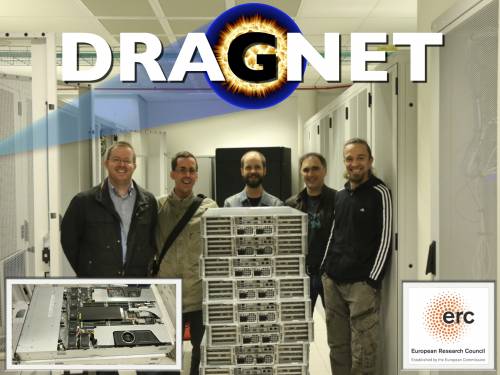Table of Contents
DRAGNET
One sentence summary: The DRAGNET project greatly extends LOFAR's detection and localization capabilities for pulsars and fast radio transients.
DRAGNET stands for Dynamic Radio Astronomy of Galactic Neutron Stars and Extragalactic Transients.
Introduction
Studying the extreme astrophysics of neutron stars, black holes and other exotica is key to understanding fundamental gravitational and particle physics. Extreme astrophysical phenomena are fleeting, however, and it is a major observational challenge to detect such fast “transients”.
DRAGNET extends LOFAR with a high-speed, wide-angle radio camera mode that is capable of detecting and localizing fast radio transients in real time. We will scan the sky for sub-second bursts coming from previously unpredicted or unobserved astrophysical phenomena, while simultaneously observing hundreds of known radio-emitting neutron stars (pulsars).
The DRAGNET project started in Jan 2014 and runs for 5 years. It is funded by an NWO VIDI and an ERC Starting Grant (+ some funding from NOVA) covering about 8 fte over 3 institutes.
Work Packages
- WP1: Wide-field transient searches
- WP2: Developing DRAGNET++
- WP3: Neutron star monitoring
- WP4: Characterizing the transient radio sky
- WP5: Understanding neutron star magnetospheres
Publications
Projects and Partners
LOTAAS and DRAGNET searches
ASTRON/LOFAR
Project Members
- Jason W. T. Hessels (ASTRON, University of Amsterdam) (PI)
- Vlad Kondratiev (ASTRON) (science postdoc)
- Cees Bassa (ASTRON) (science postdoc)
- Alexander S. van Amesfoort (ASTRON) (technical developer (until Oct 2017))
- Daniele Michilli (University of Amsterdam) (PhD)
- Amruta Jaodand (University of Amsterdam) (PhD)
- Sotiris Sanidas (University of Amsterdam) (science postdoc)
- TBD (Oxford University) (technical developer)
Operations Pages
- XML generator wiki documentation
- resourcetool wiki documentation
- Observation to DRAGNET startup documentation and references
- Capturing and Offline Processing of RSP Raw Data with COBALT
- Important dates of stop-days and software releases
- Software release notes to assess benefit and impact of using a new LOFAR version
Infrastructure
- Cluster Usage: login, environment, hostnames, job submission with SLURM, …
- System Software: raw list of non-default system settings and installed applications on top of ansible config
- Hardware Specifications: cluster figure, types of CPUs, memory, disks, GPUs, networks, …
- Cluster benchmark numbers: measured performance of various components on synthetic workloads (upper bounds)
- Cluster Support Info: support/warranty calls with our vendor
- GPU Cluster Tendering (2015)
Presentations
The LOFAR slides site also contains most DRAGNET science and technical presentations (.pdf).
Status
Grants
Daily Images
ASTRON & JIVE daily image (AJDI) submissions (or contributions) by DRAGNET(-paid) project members.
- Moonset from La Palma (3 October 2017)
- It's LOFAR Pulsar Observing Time! (21 June 2017)
- CEP4 Pulsar pipeline is ready! (14 September 2016)
- A LOFAR Census of Millisecond Pulsars (12 September 2016)
- LOFAR's view on pulsar sky (9 September 2016)
- An extraordinary binary system (17 June 2016)
- First LOFAR millisecond pulsar discovery (19 April 2016)
- Searching for pulsars with coherent dedispersion (1 December 2015)
- The Zoo of Accreting Compact Objects (28 August 2015)
- Neutron stars strike back at black holes in jet contest (5 August 2015)
- DRAGNET GPU Cluster Delivered (24 July 2015)
- LOFAR Discovers its First RRAT (10 April 2015)
- The first low-frequency limit on Fast Radio Bursts (3 October 2014)
- A day in the life of a millisecond pulsar (19 August 2014)
- Vidi grant for Jason Hessels (22 May 2013)
